Page All: Viewing All Pages
Page 1
<B>Intro</B>:
<center> </center>
</center>
Another piece of hardware graces my desk here at the house of ASEville. As you may or may not know, <a href="http://www.sis.com.tw">SiS</a> is a major supplier of chipsets, competing easily with the likes of VIA and Intel. Today, I'll be test driving the latest single channel chipset from SiS, the 648FX. All this comes on a very special board called reference.
<B>How it works</B>:
This is another first for the site and I want to take this time to explain the SiS 648FX. I won't go into boring detail either, so it will be an easy read.
<center> </center>
</center>
Above shows how this board works. The SiS 648FX itself is the northbridge only and it is a single channel Pentium 4 chipset. Included in the chipset is a multitude of features. Hyper-Threading is supported as is the new 800Mhz FSB Intel Pentium 4 CPUs. The chipset also supports 3 sticks of RAM, but only 2 when in DDR400 mode. AGP 8x and MuTIOL 1G (Meaning quick transfer to the southbridge and back) are included as well.
The Southbridge is equally impressive, supporting USB 2, ethernet, modem, audio, and more. Onboard is the serial ATA controller (The SiS 180).
Now ask yourself when you read all the technical babble if you really care how it works? You basically care that it works! And that's what we will be doing.
<B>No Box</B>:
Skipping this section due to the fact that this is reference board. Doh!
<B>The Board</B>:
<center> </center>
</center>
I really don't want to over indulge on this section of the review, after all, it is a reference board. Now, let me just let you know of the fun I had with this thing. First of all, it is overly large. BIG! Take a gander at this one.
<center> </center>
</center>
This board did not fit in any case I had, so I had to use my patented on the desk technique.
<center> </center>
</center>
Here we have the actual 648FX chipset in all its glory. There is no heatsink on it. I'll reserve judgment on the board features until I receive some retails boards from manufactures.
<center> </center>
</center>
This is the 963 southbridge, connected to the northbridge by the extra large pipe. In the old days, the northbridge and the southbridge communicated by the PCI bus (at 133 MB/s). Today, that is painfully slow.
<center> </center>
</center>
This is the area around the CPU socket, as with all Intel motherboards, the heatsink retention thing makes the socket area nice and clear. There are a nice array of capacitors around the left side of the socket, but if you don't have an extra large heatsink it should be fine (and this is a reference board and you'll never be buying one).
<center> </center>
</center>
Here are the memory sockets, remember that you can only use two slots in DDR400 mode. I'm not sure if this is the same on other boards, we'll see.
<center> </center>
</center>
The IDE ports and how you turn the board on are located here! The little push buttons are the reset and power switches. Interesting isn't it?
<B>Intro</B>:
<center>
 </center>
</center>Another piece of hardware graces my desk here at the house of ASEville. As you may or may not know, <a href="http://www.sis.com.tw">SiS</a> is a major supplier of chipsets, competing easily with the likes of VIA and Intel. Today, I'll be test driving the latest single channel chipset from SiS, the 648FX. All this comes on a very special board called reference.
<B>How it works</B>:
This is another first for the site and I want to take this time to explain the SiS 648FX. I won't go into boring detail either, so it will be an easy read.
<center>
 </center>
</center>Above shows how this board works. The SiS 648FX itself is the northbridge only and it is a single channel Pentium 4 chipset. Included in the chipset is a multitude of features. Hyper-Threading is supported as is the new 800Mhz FSB Intel Pentium 4 CPUs. The chipset also supports 3 sticks of RAM, but only 2 when in DDR400 mode. AGP 8x and MuTIOL 1G (Meaning quick transfer to the southbridge and back) are included as well.
The Southbridge is equally impressive, supporting USB 2, ethernet, modem, audio, and more. Onboard is the serial ATA controller (The SiS 180).
Now ask yourself when you read all the technical babble if you really care how it works? You basically care that it works! And that's what we will be doing.
<B>No Box</B>:
Skipping this section due to the fact that this is reference board. Doh!
<B>The Board</B>:
<center>
 </center>
</center>I really don't want to over indulge on this section of the review, after all, it is a reference board. Now, let me just let you know of the fun I had with this thing. First of all, it is overly large. BIG! Take a gander at this one.
<center>
 </center>
</center>This board did not fit in any case I had, so I had to use my patented on the desk technique.
<center>
 </center>
</center>Here we have the actual 648FX chipset in all its glory. There is no heatsink on it. I'll reserve judgment on the board features until I receive some retails boards from manufactures.
<center>
 </center>
</center>This is the 963 southbridge, connected to the northbridge by the extra large pipe. In the old days, the northbridge and the southbridge communicated by the PCI bus (at 133 MB/s). Today, that is painfully slow.
<center>
 </center>
</center>This is the area around the CPU socket, as with all Intel motherboards, the heatsink retention thing makes the socket area nice and clear. There are a nice array of capacitors around the left side of the socket, but if you don't have an extra large heatsink it should be fine (and this is a reference board and you'll never be buying one).
<center>
 </center>
</center>Here are the memory sockets, remember that you can only use two slots in DDR400 mode. I'm not sure if this is the same on other boards, we'll see.
<center>
 </center>
</center>The IDE ports and how you turn the board on are located here! The little push buttons are the reset and power switches. Interesting isn't it?
Page 2
<B>Testing Methodology</B>:
I testing this board again my IS7-E, as that is its direct competitor. Since this is a reference board, I did not do any overclocking tests.
<B>Benchmarks</B>:
All components will be the exact some for both setups, except for the board.
P4 2.4C
512MB Crucial PC 3200
Leadtek Geforce FX 5600
WD 80GB 8MB.
DVD and CDRW
Win2k SP4
DET 44.03
Latest Intel INF drivers And latest SiS Drivers
For all benchmarks, the grey denotes the IS7-E while the red denotes the 648FX reference board. All tests that have graphics were run at 640x480 at low detail if possible. The IS7-E is running in Dual Channel mode, as there is no reason to test it without something it very well can do.
<center>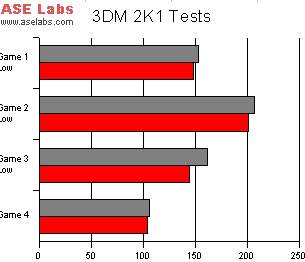 </center>
</center>
First up we have 3DMark 2001. I am showing you the individual tests. If you remember, the three games have low detail tests which really stresses the CPU subsystem and really does a nice job of testing a motherboard out. As you can see, the Intel board has a slight lead over the SiS board.
<center>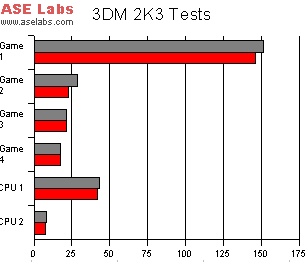 </center>
</center>
3D Mark 2003 doesn't change the picture, the Intel board is still in the lead. The SiS still shows a strong fight for a single channel board.
<center>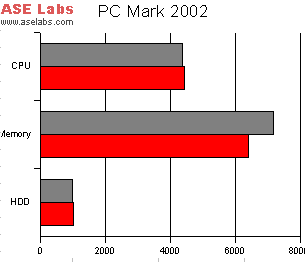 </center>
</center>
In all of PC Mark's tests, the SiS wins. All except the memory tests which is understandable due to the single memory bandwidth.
<center>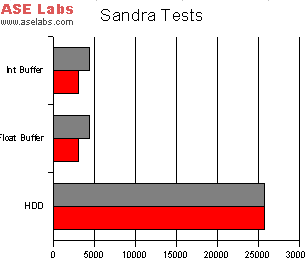 </center>
</center>
The Sandra scores paint the same picture as PC Mark. The Hard Drive performance is pretty much equal while the memory scores are in Intel's favor.
<center>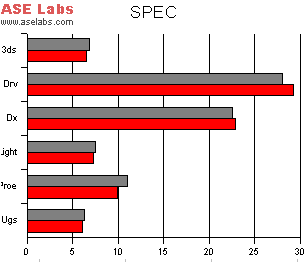 </center>
</center>
Spec is a professional suite of programs. In this benchmark, we see that the SiS board actually wins a few. I consider this a tie really.
<center>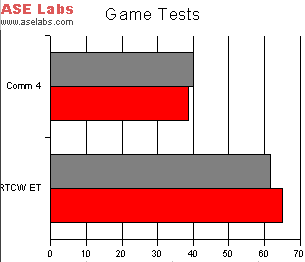 </center>
</center>
Another tie, the SiS wins an OpenGL game while the Intel wins a DirectX game.
<center>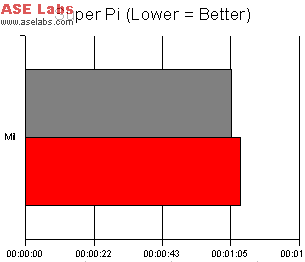 </center>
</center>
In Super Pi, the Intel board retains the leader position. All this is most likely due to the extra memory bandwidth.
<B>Testing Methodology</B>:
I testing this board again my IS7-E, as that is its direct competitor. Since this is a reference board, I did not do any overclocking tests.
<B>Benchmarks</B>:
All components will be the exact some for both setups, except for the board.
P4 2.4C
512MB Crucial PC 3200
Leadtek Geforce FX 5600
WD 80GB 8MB.
DVD and CDRW
Win2k SP4
DET 44.03
Latest Intel INF drivers And latest SiS Drivers
For all benchmarks, the grey denotes the IS7-E while the red denotes the 648FX reference board. All tests that have graphics were run at 640x480 at low detail if possible. The IS7-E is running in Dual Channel mode, as there is no reason to test it without something it very well can do.
<center>
 </center>
</center>First up we have 3DMark 2001. I am showing you the individual tests. If you remember, the three games have low detail tests which really stresses the CPU subsystem and really does a nice job of testing a motherboard out. As you can see, the Intel board has a slight lead over the SiS board.
<center>
 </center>
</center>3D Mark 2003 doesn't change the picture, the Intel board is still in the lead. The SiS still shows a strong fight for a single channel board.
<center>
 </center>
</center>In all of PC Mark's tests, the SiS wins. All except the memory tests which is understandable due to the single memory bandwidth.
<center>
 </center>
</center>The Sandra scores paint the same picture as PC Mark. The Hard Drive performance is pretty much equal while the memory scores are in Intel's favor.
<center>
 </center>
</center>Spec is a professional suite of programs. In this benchmark, we see that the SiS board actually wins a few. I consider this a tie really.
<center>
 </center>
</center>Another tie, the SiS wins an OpenGL game while the Intel wins a DirectX game.
<center>
 </center>
</center>In Super Pi, the Intel board retains the leader position. All this is most likely due to the extra memory bandwidth.
Page 3
Overclocking:
None, reference board!
<B>Conclusion</B>:
Another review reaches its conclusion. Actually, this chipset shows real promise considering it does very well against a dual channel chipset. I hope to see retail boards in the future based on this and SiS also has a new dual channel chipset as well. SiS is making some really nice chipsets, and competition is very good for us consumers. If you see a board based on the 648FX and it is cheap enough, I'd consider it a buy.
I'd like to thank <a href="http://www.sis.com.tw">SiS</a> for sending this board for review.
Overclocking:
None, reference board!
<B>Conclusion</B>:
Another review reaches its conclusion. Actually, this chipset shows real promise considering it does very well against a dual channel chipset. I hope to see retail boards in the future based on this and SiS also has a new dual channel chipset as well. SiS is making some really nice chipsets, and competition is very good for us consumers. If you see a board based on the 648FX and it is cheap enough, I'd consider it a buy.
I'd like to thank <a href="http://www.sis.com.tw">SiS</a> for sending this board for review.